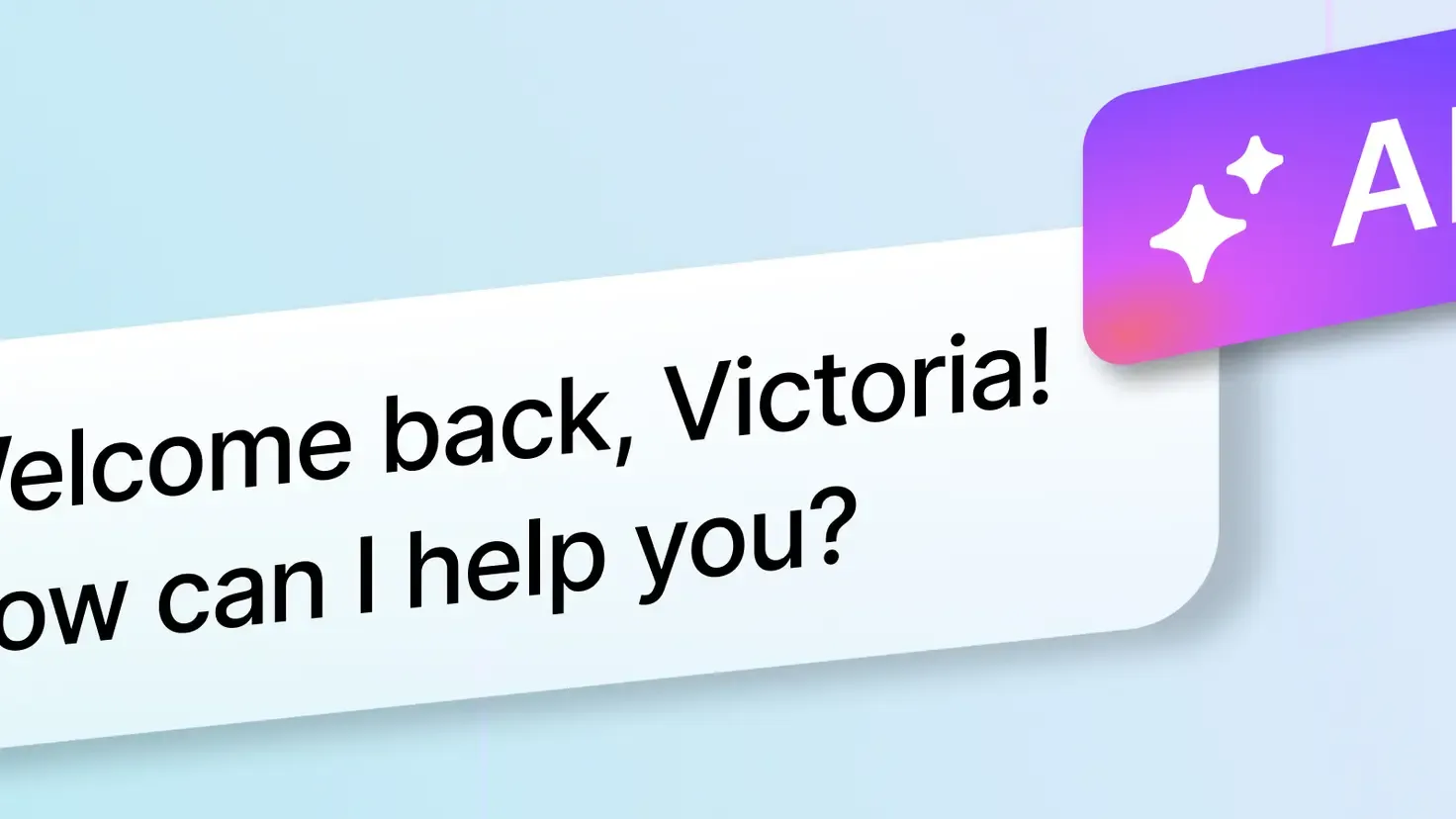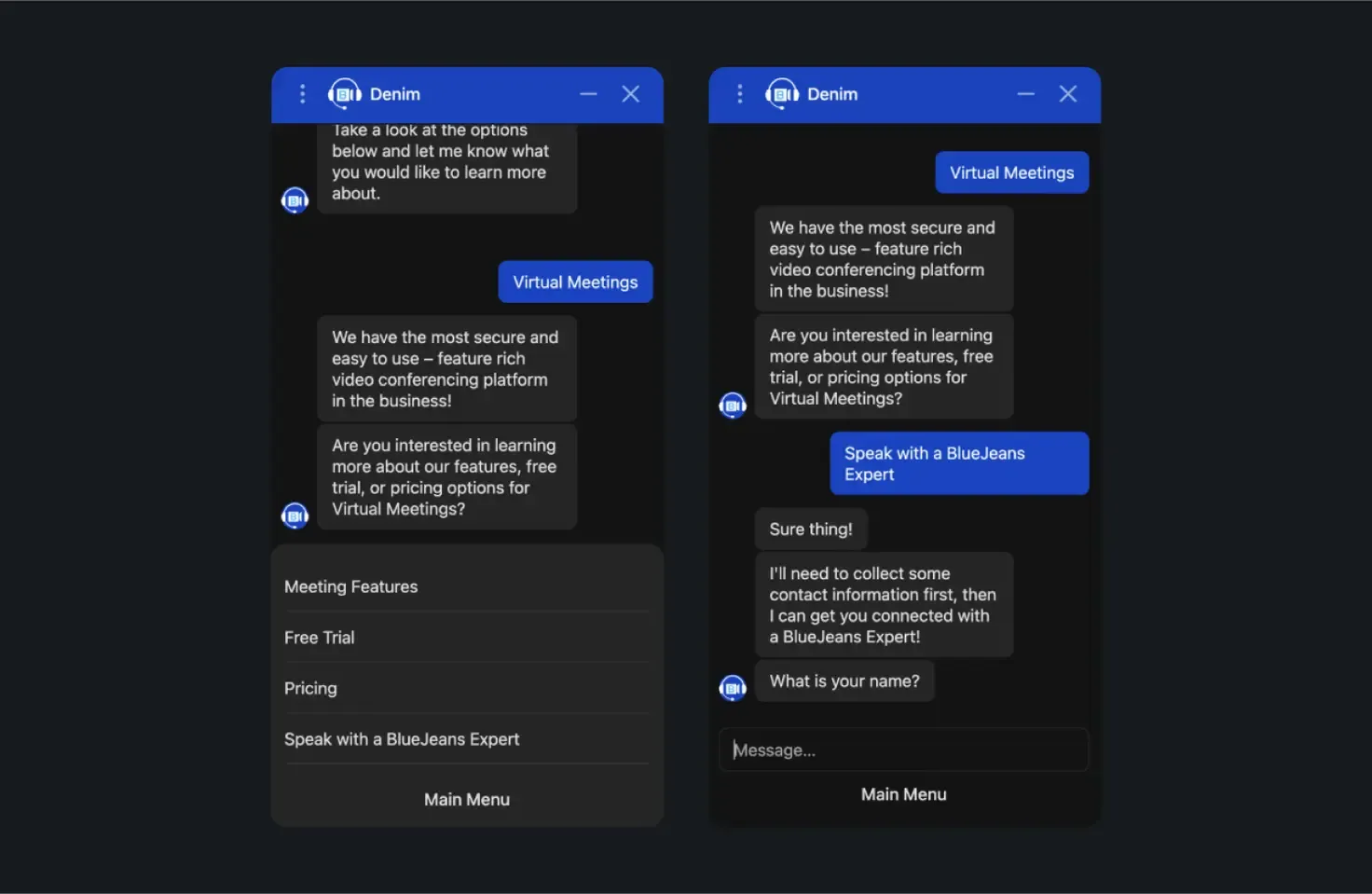
Guide to interviewing AI Agents
What makes an AI Agent different from the typical chatbots you’ve used in the past? Is the impact on ROI really that high?
Learn More

Computer-powered assistance is everywhere, and goes by many different names: Chatbot. Bot. Virtual assistant. Voice assistant. Conversational AI.
Businesses use conversational interfaces to provide customers with top-quality service around the clock and reduce costs while improving customer engagement. Customers use them to do everything from finding answers to taking action — at their convenience, without having to wait for an agent.
With major benefits to both sides, it’s no wonder the global chatbot market is predicted to reach $9.4B by 2024 .
But with so many different buzzwords being thrown around, it can be hard to know exactly what technology we’re talking about. The terms “conversational AI” and “chatbot” are often used interchangeably — so much so that you might think they’re the same.
But they aren’t. Not exactly.
Before you can determine which technology is best suited to your customer service needs, you have to understand the difference.
Let's start with some definitions.
A chatbot is a computer program that uses automation to mimic human conversation.
Conversational AI is broader AI technology that uses more advanced techniques allowing brands to have intelligent, two-way conversations with users.Some chatbots are conversational AI — but not all.
“Chatbot” is often used as a catchall for automated conversations. But by definition, a chatbot is just a basic software program capable of generating text to carry out human conversations with a business via their website or mobile app.
By now, most of you would immediately recognize the little chat window that pops up on the bottom right of a website. And if it doesn’t pop up automatically, it’s usually easy to find — you can activate the chatbot by clicking on the chat icon on the web or in mobile apps.
Most chatbots today can be classified into one of two categories: rule-based or AI chatbots.
Rule-based chatbots work by following pre-set flows (or rules) that rely on predetermined questions and answers to map out potential conversations. These basic bots are great for answering FAQs, scheduling appointments, and handling simple, routine customer service inquiries, such as checking the status of an order (WISMO) or resetting a password.
However, if a customer’s question doesn’t fit into one of the predetermined boxes, the chatbot will get stuck — kind of like a Roomba that’s wandered into a corner.
Basic chatbots do a good job of guiding customers through the conversation flow step by step. Similar to the old-school menu trees customers used to navigate when phoning a call center, users can select from a series of options to find what they’re looking for. They just can’t color outside the lines, so to speak.
To support more complex interactions, the chatbot needs a little more juice. That’s where conversational AI comes into play.
The main difference between a basic chatbot and conversational AI is the use of natural language processing (NLP) and machine learning (ML) to take the conversation to the next level — and break free from the pre-set flow.
This allows conversational AI to better understand and process human language and power more intelligent automated conversations with humans.
Chances are you’re already interacting with conversational AI every day, even if you don’t realize it. Siri, Google Assistant, and Amazon Alexa, for example, all use ML to power a more seamless user experience.
Plenty of B2C chatbots are also using conversational AI. To give customers a truly exceptional service experience, pair it with a live agent interface. This way, you can automate the bulk of customer interactions and provide smooth handoff when needed.

With the right automation platform, brands should be able to route interactions to the best agent, depending on their needs, and personalize the experience at every step of the customer journey — which is vital to today’s socially aware consumers. This holistic approach is the missing link for forward-looking brands ready to take the next step in the customer service evolution.
In the era of instant gratification, with virtual assistants in every device and same-day shipping almost expected, it’s more important than ever to make every single interaction count. To gain an edge over fierce competition, brands have to work to make interactions truly engaging, fast, and friendly — at massive scale.
Notice we said “technologies” (plural) above. Here’s what we’re talking about.
Real talk: NLP enables computer programs to understand everyday language, not just pre-programmed phrases, which means customers can speak (or type) naturally. NLP combines rule-based language models with ML and deep learning models to detect intent and sentiment, no matter how it’s phrased. This applies to both text and speech and includes things like slang, regional dialect, and common misspellings.
Ongoing improvement: Conversational AI uses ML to learn from every interaction, enabling continual improvement and optimizing service based on customer data and history. With this added layer of intelligence, the chatbot will get better and better the more it’s used.
Here, there, everywhere: Conversational AI’s omnichannel capabilities let companies extend support beyond the website to include other popular channels like instant messaging, social media, and in-app. Letting customers choose where to self-serve boosts convenience and ease. Plus, conversational AI can collect user data and communicate with new customers on their platform of choice, driving repeat purchases and raising conversion rates.
Get personal: Shared values matter today, which is why it’s more important than ever to personalize customer service as much as possible. Conversational AI makes it easy by surfacing relevant customer insights in real time. Brands can tailor things like prompts, response tone, and answer flows to suit customer preferences.
Now that we’ve covered the key differences between chatbots and conversational AI, let’s look at some of the top use cases for conversational AI for customer service — and the benefits that are baked into them.
With a conversational AI-powered chatbot, businesses can automate up to 90% of customer inquiries, including FAQs and the most common queries, such as WISMO. A branded chatbot plus personalization will enhance trust and loyalty while reducing cost per conversation and agent burnout.
Conversational AI for customer service should be:
Making it easy for customers to get things done without waiting for an agent is a top priority for most businesses — and a top benefit of conversational AI. Neptune Flood added conversational AI to their website to allow their growing customer base to self-serve for things like canceling a policy (which isn’t as simple as it sounds) and submitting claims.
When Hurricane Ian struck Neptune’s head office, the company was able to get their own employees to safety while continuing to process claims — around 35% of which were done using Ada. With self-service available for the majority of policy-holder queries, Neptune has decreased resolution time by 92% and cost per ticket by 78%.
For growing companies, keeping up with an escalating volume of customer service requests can be a real challenge. Long wait times quickly damage your brand reputation, but adding new agents takes time and drives up costs.
AirAsia added conversational AI to their website and reduced customer service wait times by 98% in just four weeks — from almost an hour to less than a minute. In addition to offering support in 11 languages, the leading airline is now able to resolve 75% of interactions using conversational AI-powered chatbots. Customer satisfaction jumped 30 points, from 60% to 90%, and they saw an 8x increase in ancillary product up-sell/cross-sells.

Many ecomm and retail companies make the bulk of their revenue during the busy holiday shopping season. To handle the customer service spike, they may have to double or even triple their support teams and get new agents up to speed super fast.
Naturally, costs also skyrocket. For Photobox , which makes 70% of their revenue during the holidays, adding conversational AI to their website to scale up service during this busy period reduced their operating costs by 15%, saving the company $732k in the first year alone. With 24/7 self-service now available in six languages and a 52% containment rate, Photobox is always ready for the next rush.
For businesses operating in multiple countries or looking to expand to new markets, conversational AI’s multilingual capabilities can help. Malaysian super-app Grab implemented an AI-powered digital assistant on Facebook Messenger, serving six countries across the region. In addition to reaching new markets, Grab has reduced operational costs by 23% and slashed ticket backlog by 90%.
Creating a consistent digital experience is important for building brand loyalty. When expanding to new platforms or markets or merging with another company, this may require some work.
Top beauty subscription brand Ipsy used conversational AI to create a unified customer experience when they acquired BoxyCharm — saving around $2.7M a year in service costs and reducing response times by an entire day. They’ve also cut resolution time by 19 hours and increased customer satisfaction nearly 20%. And as the company continues to grow, they can offer a personalized approach and consistent brand presence wherever they go next.
Many established companies are still relying on the legacy systems that have always supported them, which often means localized call centers. But in today’s digital-first world, this probably isn't serving your business goals — or your customers.
With 90% of customer service queries being handled by regional call centers, the Caribbean's leading mobile phone provider, Digicel , knew they needed to adopt a digital-first customer service strategy. By implementing conversational AI on their website, Digicel was able to divert 135k conversations per month away from call centers, saving $750k in service costs. Plus, the singular bot serves 31 markets in five languages.
Sometimes customers need help while they’re using your website or app. If they have to send a request and wait for a response, it’s not a good customer experience. Automating in-app support can help.
Tango Card helps businesses drive success with rewards and incentives in the form of digital gift cards. When the company experienced an uptick in help tickets, they turned to conversational AI to provide effective in-app support. In addition to reducing ticket volumes by 10% (while sending more gift cards than ever before), Tango achieved 70% containment and an 83% improvement in average first response time.
Conversational AI isn’t limited to digital interactions. It can also be used for voice — which, after all, is still the most popular customer service channel. (Also, the most expensive.) Letting customers speak their way through self-service lowers costs and frees up agents to focus on more complex matters, strengthening customer relationships.
Before you shudder at the thought of those frustrating menus that traditional interactive voice response (IVR) systems forced callers through, remember we’re talking about a conversational AI voice bot — which includes NLP and ML. Callers can speak naturally and the AI will detect their intent, even with slang and accent variations. It’s the difference between just understanding what you’re saying and understanding what you actually mean.
If you’re already using a conversational AI chatbot on your website and messaging apps, you should be able to deploy the same automation on your voice channel without having to start over. (Assuming you chose a multimodal platform like Ada.)
Adding any new technology to your customer service stack can be daunting, but it doesn't have to be. With a no-code conversational AI platform, companies can build powerful, enterprise-grade customer service automation with minimal effort — or technical input. This means you can empower the people who know your customers best to design, manage, and improve automation: your CX team. (Not your IT department.)
Choose a platform that integrates seamlessly with existing business systems, including backend systems such as Shopify and agent tools like Zendesk. This way you can take advantage of all your available information, accelerating resolution and making it easy to personalize conversations. A multimodal platform also allows you to provide consistent customer service across both digital and voice channels.
With NLU helping to accurately interpret customer intent and advanced AI that’s able to take action, your conversational AI chatbot will be ready to resolve more customer queries, faster. Add generative AI to create conversational FAQs at record speed and continually improve intent recognition, and you’ve got a game changing strategy.
As technology continues to advance, customer expectations continue to rise — and keeping up means staying ahead of the curve. In the realm of customer service, leaders look to take advantage of every available tool so they can provide the best possible customer service. Conversational AI allows brands to resolve more queries without escalation, empower agents in the cases that do require hands-on help, and continually improve the customer experience with every interaction, building long-term loyalty and success.
Want to see for yourself what our award-winning conversational AI chatbot can do for your business?
Schedule demo